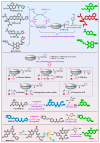Fluorescent Probes for Mammalian Thioredoxin Reductase: Mechanistic Analysis, Construction Strategies, and Future Perspectives
- PMID: 37622897
- PMCID: PMC10452626
- DOI: 10.3390/bios13080811
Fluorescent Probes for Mammalian Thioredoxin Reductase: Mechanistic Analysis, Construction Strategies, and Future Perspectives
Abstract
The modulation of numerous signaling pathways is orchestrated by redox regulation of cellular environments. Maintaining dynamic redox homeostasis is of utmost importance for human health, given the common occurrence of altered redox status in various pathological conditions. The cardinal component of the thioredoxin system, mammalian thioredoxin reductase (TrxR) plays a vital role in supporting various physiological functions; however, its malfunction, disrupting redox balance, is intimately associated with the pathogenesis of multiple diseases. Accordingly, the dynamic monitoring of TrxR of live organisms represents a powerful direction to facilitate the comprehensive understanding and exploration of the profound significance of redox biology in cellular processes. A number of classic assays have been developed for the determination of TrxR activity in biological samples, yet their application is constrained when exploring the real-time dynamics of TrxR activity in live organisms. Fluorescent probes offer several advantages for in situ imaging and the quantification of biological targets, such as non-destructiveness, real-time analysis, and high spatiotemporal resolution. These benefits facilitate the transition from a poise to a flux understanding of cellular targets, further advancing scientific studies in related fields. This review aims to introduce the progress in the development and application of TrxR fluorescent probes in the past years, and it mainly focuses on analyzing their reaction mechanisms, construction strategies, and potential drawbacks. Finally, this study discusses the critical challenges and issues encountered during the development of selective TrxR probes and proposes future directions for their advancement. We anticipate the comprehensive analysis of the present TrxR probes will offer some glitters of enlightenment, and we also expect that this review may shed light on the design and development of novel TrxR probes.
Keywords: 1,2-dithiolane; diselenide; disulfide; fluorescent probe; redox chemistry; selenenylsulfide; thioredoxin; thioredoxin reductase.
Conflict of interest statement
The authors declare no conflict of interest.
Figures











Similar articles
-
A Diselenide Turn-On Fluorescent Probe for the Detection of Thioredoxin Reductase.Angew Chem Int Ed Engl. 2020 Aug 24;59(35):15147-15151. doi: 10.1002/anie.202004094. Epub 2020 Jun 17. Angew Chem Int Ed Engl. 2020. PMID: 32449244 Free PMC article.
-
Activity assays of mammalian thioredoxin and thioredoxin reductase: fluorescent disulfide substrates, mechanisms, and use with tissue samples.Anal Biochem. 2014 Mar 15;449:139-46. doi: 10.1016/j.ab.2013.12.025. Epub 2013 Dec 27. Anal Biochem. 2014. PMID: 24374250
-
Small Molecules to Target the Selenoprotein Thioredoxin Reductase.Chem Asian J. 2018 Dec 4;13(23):3593-3600. doi: 10.1002/asia.201801136. Epub 2018 Oct 17. Chem Asian J. 2018. PMID: 30204305 Review.
-
Highly selective off-on fluorescent probe for imaging thioredoxin reductase in living cells.J Am Chem Soc. 2014 Jan 8;136(1):226-33. doi: 10.1021/ja408792k. Epub 2013 Dec 18. J Am Chem Soc. 2014. PMID: 24351040
-
Recent Advances in the Fluorescent Probes for Flavinase Activity: Design and Applications.Chem Asian J. 2022 Apr 1;17(7):e202200043. doi: 10.1002/asia.202200043. Epub 2022 Mar 3. Chem Asian J. 2022. PMID: 35174973 Review.
Cited by
-
Thioredoxin System in Insects: Uncovering the Roles of Thioredoxins and Thioredoxin Reductase beyond the Antioxidant Defences.Insects. 2024 Oct 14;15(10):797. doi: 10.3390/insects15100797. Insects. 2024. PMID: 39452373 Free PMC article. Review.
-
Building a Human Ovarian Antioxidant ceRNA Network "OvAnOx": A Bioinformatic Perspective for Research on Redox-Related Ovarian Functions and Dysfunctions.Antioxidants (Basel). 2024 Sep 12;13(9):1101. doi: 10.3390/antiox13091101. Antioxidants (Basel). 2024. PMID: 39334761 Free PMC article. Review.
-
Selenium Nucleophilicity and Electrophilicity in the Intra- and Intermolecular SN2 Reactions of Selenenyl Sulfide Probes.Chemistry. 2025 Feb 25;31(12):e202404580. doi: 10.1002/chem.202404580. Epub 2025 Feb 3. Chemistry. 2025. PMID: 39847043 Free PMC article.
-
Cysteine Alkylation in Enzymes and Transcription Factors: A Therapeutic Strategy for Cancer.Cancers (Basel). 2025 Jun 3;17(11):1876. doi: 10.3390/cancers17111876. Cancers (Basel). 2025. PMID: 40507356 Free PMC article. Review.
References
Publication types
MeSH terms
Substances
Grants and funding
LinkOut - more resources
Full Text Sources
Miscellaneous

